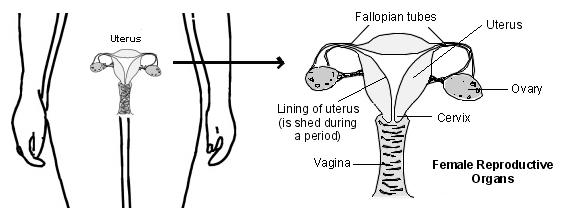Periods and period problems
Peer reviewed by Dr Toni Hazell, MRCGPLast updated by Dr Hayley Willacy, FRCGP Last updated 13 Feb 2023
Meets Patient’s editorial guidelines
- DownloadDownload
- Share
- Language
- Discussion
In this series:Missed periodsHeavy periodsPremenstrual syndromeFibroidsHow to delay a periodEndometrial biopsy
Starting to have periods is part of growing up. Periods start to occur around the same time as other changes happen to the body, such as starting to develop breasts or to grow pubic hair. The average age to start periods is 13 but it is normal to start at any time between the ages of 9 and 15. A small number of girls may start before or after this. Periods continue until the menopause which is usually around the age of 50 years.
Note: for the purposes of this patient information leaflet, 'girls, females or women' are those individuals who are assigned to be female at birth. It is not intended to exclude or dismiss individuals who do not identify as female.
In this article:
What are the different types of period problems?
Continue reading below
What is a period?
For several days each month there is blood loss from the vagina. The amount of blood loss varies from period to period, and between women. The nature of the blood loss may also vary with some women having a dark scanty loss, and others having a heavier loss which is a brighter red. Sometimes clots are passed, especially if the loss is heavy. Sometimes there are small flaky fragments in with the menstrual blood. A normal amount of blood loss during each period is between 20 and 60 ml. (This is about 4 to 12 teaspoonfuls.) Bleeding can last up to eight days but five days is the average. The bleeding is usually heaviest on the first two days. Some pain in the lower tummy (abdomen) and pelvic pain - period pain - is common and normal.
Sanitary towels or tampons?
When you have a period, you will need to use something to absorb the blood you lose. It is common to use sanitary towels when periods first start. These are placed in your underwear to soak up the blood. They come in different sizes and styles. You may need a pad which is bigger or bulkier at night, or on the heavy days of your period. When it is light, a small panty liner may be enough.
Tampons, which you insert into your vagina to absorb the blood, can be more convenient. They need to be changed regularly. You can start to use tampons at any age after you start having periods. They may feel uncomfortable to start with and may take a little bit of practice to get used to. There are different sizes, so start with the smallest to get used to it. You may need to use several sizes of tampon during a period, depending on how heavy the bleeding is. A larger size may be needed in the early heavy stages, then a smaller one when bleeding becomes lighter. Some tampons come with an applicator. Other types are put in with your fingers. Some women prefer one type, others another. You will find the one which is easiest for you.
Sometimes you may like to mix and match - for example, using tampons for swimming but pads at other times. For very heavy periods you may even need to use both together.
An alternative to towels and tampons is a menstrual cup. This is a reusable device, about two inches long which is made from soft medical-grade silicone. It is placed in the vagina. The cup collects menstrual blood. It is folded and inserted into the vagina, then removed. It can be rinsed and reinserted up to every eight hours.
Another alternative is re-usable period pants. They are designed to avoid leakages and be more comfortable than towels or tampons.
See the separate article called Supporting your child when they start menstruation for more details.
Can you get pregnant during your period?
Although unlikely, it is possible to get pregnant by having sex during your period. Sperm can stay alive inside you for up to five days. So if you ovulate early and have a short menstrual cycle (see below) then it is possible for you to become pregnant. See below for more information about ovulation and the menstrual cycle.
Do I have to avoid anything when I have a period?
No. Carry on as normal. If you find the periods painful, regular exercise sometimes helps. Periods are not dirty; they are a normal part of a woman's life. You can go swimming, have a bath, etc. You may prefer to use tampons if you enjoy swimming.
Continue reading below
What is the menstrual cycle?
Small organs called ovaries lie in the lower part of their tummy (abdomen). The ovaries lie either side of the womb (uterus). The ovaries start to produce female hormones around puberty which cause changes to the uterine lining. Every month during your period the lining of your womb is shed together with some blood.
Female reproductive organs (periods)

How long does a menstrual period last?
The time between the start of one period and the start of the next is called the menstrual cycle. The average length of a menstrual cycle is 28 days. However, anything between 24 and 35 days is common. During the cycle various changes occur in your body. The changes are controlled by chemical substances called hormones, which act like messengers in your body. There are changing amounts of your female hormones at different times of your cycle. The menstrual cycle is split roughly into two halves:
The first half of your cycle is called the follicular or proliferative phase. The levels of two main hormones, oestrogen and progesterone, are low to start with and you shed the inner lining of your womb (endometrium). This causes your period (menstrual bleeding).
During this phase your ovaries are stimulated by other hormones. These travel to the ovary in the bloodstream from a gland near your brain, called the pituitary gland. One of these hormones causes some eggs in your ovaries to grow and develop in tiny fluid-filled cavities called follicles. The follicles produce oestrogen. Throughout the first half of your cycle the level of oestrogen in your blood rises. One function of oestrogen is to cause the lining of your womb to thicken (proliferate).
Ovulation occurs about halfway through your cycle (about 14 days after the start of your period). Ovulation is the release of an egg into your Fallopian tube from a follicle in an ovary. The egg travels along your Fallopian tube into your womb. The egg may be fertilised if you have recently had sex and there are sperm in your womb.
The second half of the cycle is called the secretory or luteal phase. After ovulation, the follicle that released the egg makes a hormone called progesterone as well as oestrogen. Progesterone causes the lining of the uterus to swell and be ready to receive a fertilised egg. If the egg is not fertilised, the levels of progesterone and oestrogen gradually fall. When they fall to a low level, they lose their effect on your womb. The lining of your womb is then shed (a period) and a new cycle then begins.
Some symptoms relating to periods
In general, if you have a change from your usual pattern that lasts for several periods, it may be abnormal. You should contact a doctor if this occurs.
Heavy periods (menorrhagia)
Heavy periods are very common. It is difficult to measure blood loss accurately. Periods are considered heavy if they are affecting your life and causing problems.
Painful periods (dysmenorrhoea)
Painful periods are common and you may experience an ache in your lower abdomen, back and tops of your legs, especially in the first few days of your period. The first two days are usually the worst. Some women have more pain than others. The cause of the pain is often not fully understood. Sometimes conditions such as endometriosis can make period pains become worse.
Bleeding at abnormal times
If you have vaginal bleeding at times apart from your expected periods, you should see a doctor. This includes if bleeding occurs after you have sex, or after the menopause. Bleeding after sex is also called postcoital bleeding.
Bleeding in between your periods (intermenstrual bleeding) can also occur. This has several causes. They include infections or polyps. Polyps are small fleshy lumps that can occur on the neck of the womb or inside the cavity of the womb. There are various causes of bleeding between periods:
One common cause is called breakthrough bleeding, which is small bleeds that occur in the first few months after starting the birth control pill. This usually settles over a few months.
It may be because the neck of the womb (cervix) is sore and inflamed. This can make it more likely to bleed after sex. The most common reasons for this are infections - such as chlamydia - and hormonal changes.
It is very important to see your doctor because abnormal vaginal bleeding can be caused by cancer - for example, cancer of the cervix or cancer of the womb.
Periods which stop (amenorrhoea) or are irregular
Periods may stop or become irregular. Pregnancy is the most common reason for periods to stop. However, it is not uncommon to miss the odd period for no apparent reason. Apart from pregnancy, other causes of periods stopping include stress, eating disorders, losing weight, exercising too much and hormonal imbalance. Blood tests can help diagnose the cause of the irregular bleeding.
The interval between periods can also vary between women. Irregular periods may indicate that you do not ovulate every month. Irregular periods are common in the few years leading up to the menopause.
Patient picks for Periods and period problems

Women's health
How to delay a period
Some women may wish to delay a period. This may be if a period is due at a time that would be inconvenient - for example, on a holiday or during an exam.
by Dr Toni Hazell, MRCGP

Women's health
Missed periods
Missed periods can happen for many reasons. Most of the time there is no worrying cause. As long as you are sure you are not pregnant and you feel well in yourself there is no need for concern if you miss one or two periods. If you don't have a period for 3-6 months, or have other symptoms then you should consult a doctor. Sometimes periods in teenage girls start later than in others. If your periods haven't started by the time you are 16 (or 14 if you have not started developing in other ways such as getting pubic hair and breasts) then contact your doctor. Periods can also be infrequent, erratic or irregular. If you bleed between your periods or after sex, or after the menopause, you should discuss this with your doctor.
by Dr Rosalyn Adleman, MRCGP
Further reading and references
- Management of Premenstrual Syndrome; Royal College of Obstetricians and Gynaecologists (2016)
- Heavy menstrual bleeding: assessment and management; NICE Guideline (March 2018 - updated May 2021)
- Dysmenorrhoea; NICE CKS, October 2023 (UK access only)
- Amenorrhoea; NICE CKS, February 2024 (UK access only)
Continue reading below
Article history
The information on this page is written and peer reviewed by qualified clinicians.
Next review due: 12 Feb 2028
13 Feb 2023 | Latest version

Ask, share, connect.
Browse discussions, ask questions, and share experiences across hundreds of health topics.

Feeling unwell?
Assess your symptoms online for free
Sign up to the Patient newsletter
Your weekly dose of clear, trustworthy health advice - written to help you feel informed, confident and in control.
By subscribing you accept our Privacy Policy. You can unsubscribe at any time. We never sell your data.